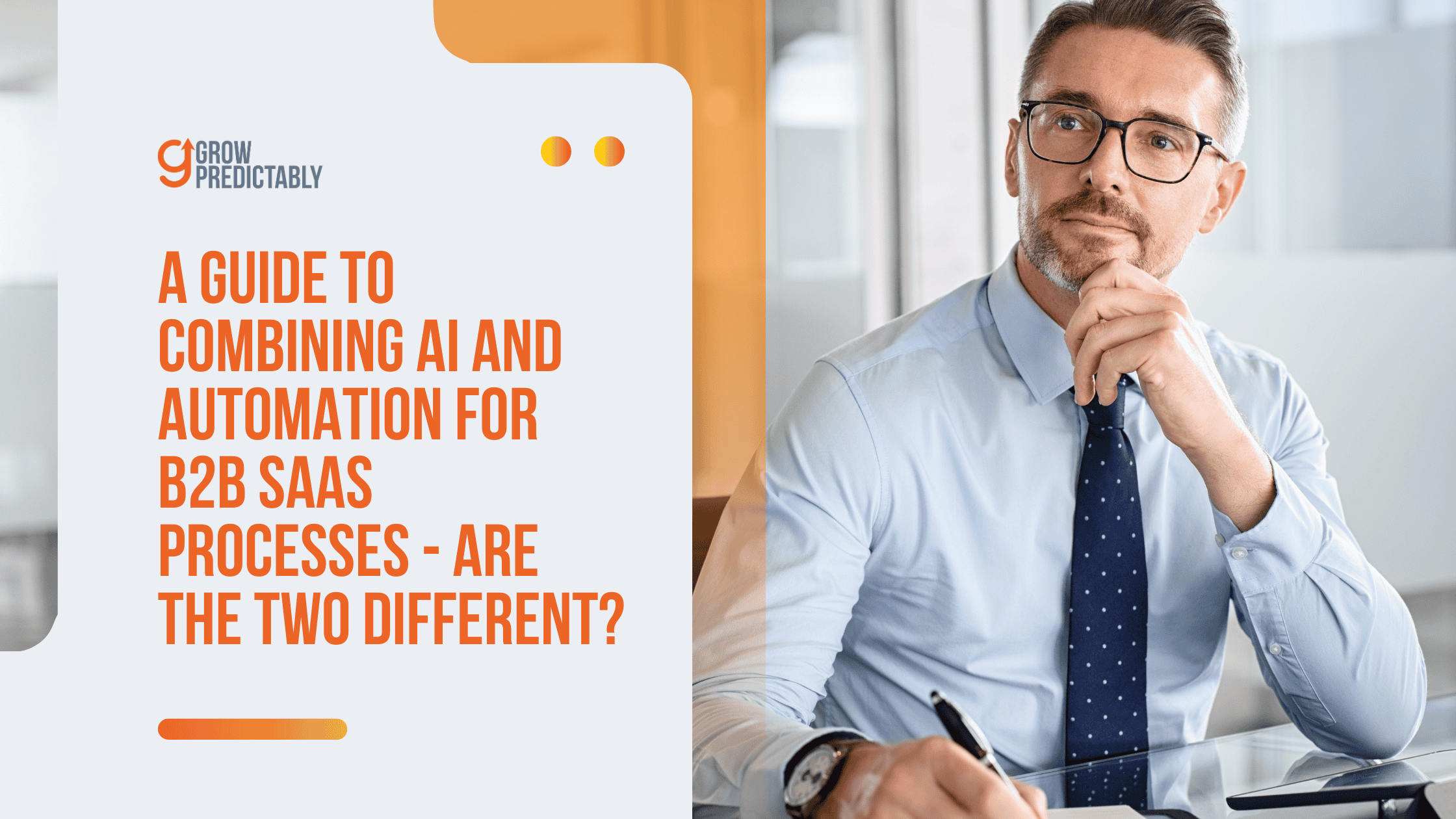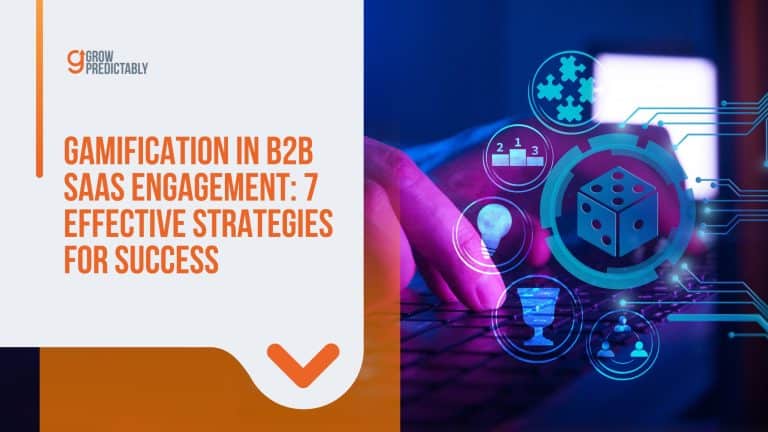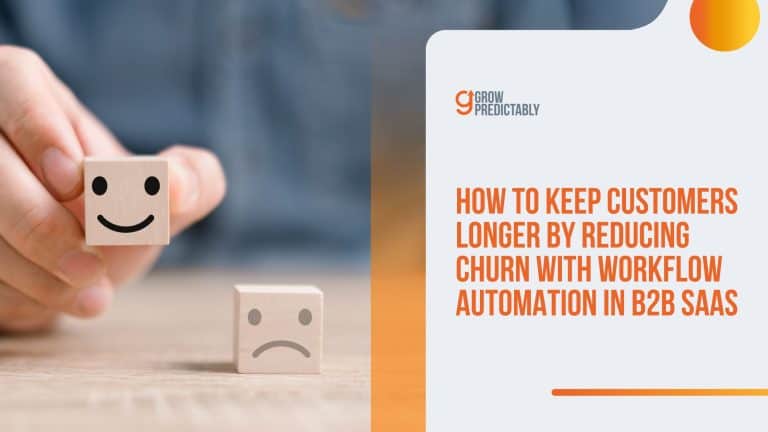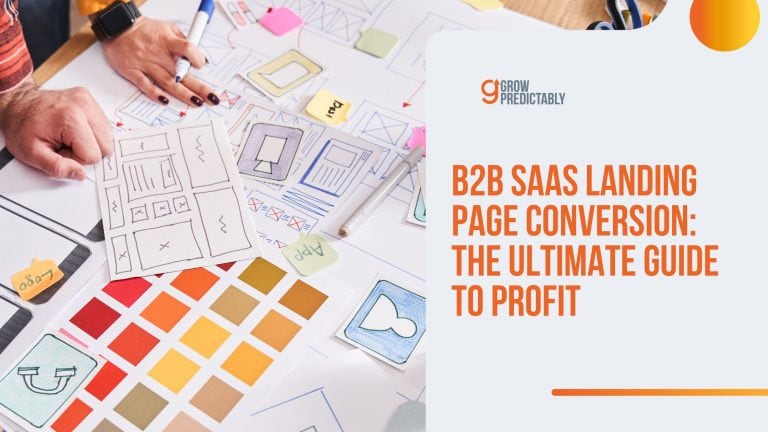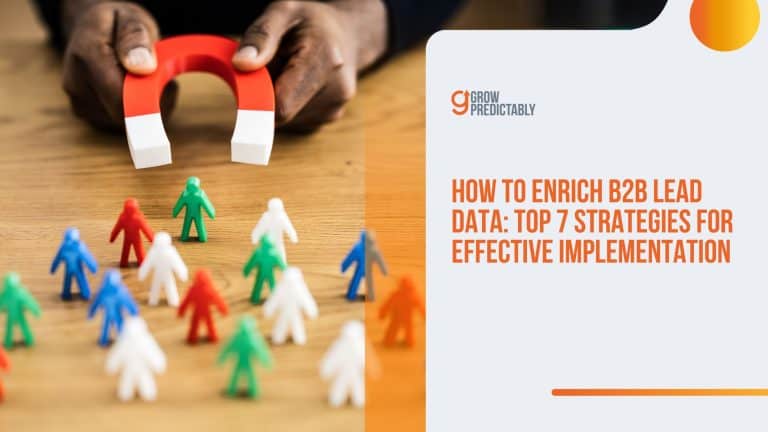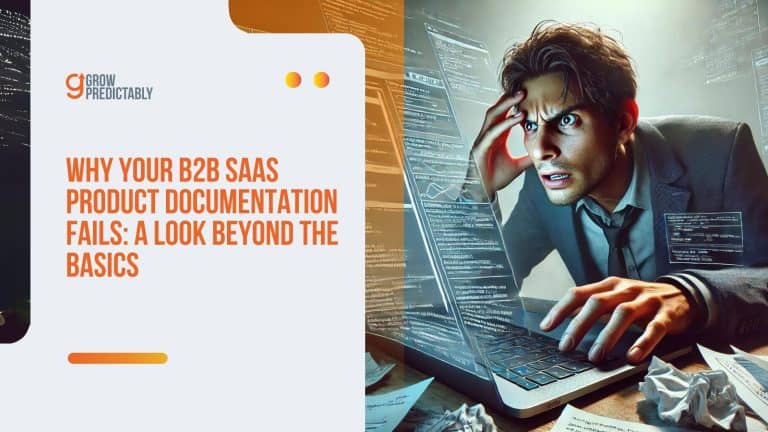A Guide to Combining AI and Automation for B2B SaaS Processes – Are The Two Different?
Tired of inefficiencies and bottlenecks in your B2B SaaS processes?
Many businesses face the same struggle when trying to integrate AI and automation—but they often fall into the trap of thinking that these technologies will “just work” on their own.
Here’s the myth: Simply adopting AI tools will automatically optimize your workflows.
In reality, it takes a thoughtful, strategic approach to combine AI and automation effectively.
The benefit?
When done right, AI-driven automation can transform your business, allowing you to operate at a level of efficiency that sets you apart.
So, where do you begin if you want to leverage AI or automation OR both in your B2B SaaS business?
Understand the need behind it first.
Why Combining AI and Automation for B2B SaaS Processes is Essential for Success
B2B SaaS businesses are all about providing software solutions that help other businesses run smoother and more efficiently.
This is what B2B SaaS businesses stand for: To help other businesses achieve their desired results efficiently.
However, how can B2B SaaS businesses achieve their desired results efficiently?
This is where AI and automation come into the picture.
Between 2015 and 2019, the number of businesses utilizing AI services grew by 270%. (Source) That’s huge! And there’s a reason behind that.
For starters, AI and automation can take on repetitive tasks, freeing up your team to focus on what really matters—like developing new features or improving customer service.
AI and automation are basically tools that analyze data in seconds, giving you insights that would take hours to gather manually.
Integrating AI into your SaaS platform means you can offer clients smarter solutions that adapt to their needs.
Automation ensures processes are consistent and error-free, which boosts your productivity and your client’s satisfaction.
Plus, when your clients see how seamless and efficient your software makes their operations, they’re more likely to stick around.
In short, by leveraging these technologies, B2B SaaS businesses not only improve their own operations but also deliver superior service, making them indispensable to their clients.
Admittedly, though, talking about the two concepts can sometimes be confusing.
To some, they’re two sides of the same coin.
But how do AI and automation really differ from each other
Are AI and Automation Two Different Things?

Yes, AI and automation are distinct but related concepts.
Here’s how you can differentiate the two.
What is Automation?
Automation refers to using technology to perform repetitive tasks or processes without human intervention. It typically follows predefined rules and workflows, like setting up automated billing or automating customer onboarding processes in SaaS systems. Automation focuses on efficiency by reducing the need for manual effort in routine tasks.
What is AI?
On the other hand, artificial intelligence involves machines or systems that can simulate human intelligence through learning, reasoning, and problem-solving. AI can analyze data, recognize patterns, make predictions, and even adapt to new scenarios without explicit programming. For example, AI in SaaS may involve using machine learning for predictive analytics or natural language processing (NLP) for customer support chatbots.
In practice, AI can enhance automation by making it more intelligent.
For instance, instead of automating a fixed process, AI-driven automation can adapt workflows based on real-time data or improve over time through learning.
While they can work together, automation is rule-based and task-oriented, whereas AI involves learning, adaptation, and decision-making based on data analysis.
Key Challenges When Combining AI and Automation in B2B SaaS
Integrating AI and automation into B2B SaaS can bring positive and impactful changes to your business when done right, but it’s not always a smooth ride.
Knowing the challenges ahead can help you steer clear of common pitfalls when implementing these technologies in your SaaS business.
Let’s break down the three major hurdles you might face.
| Problem | Description | What to Do? |
|---|---|---|
| Technical Challenges | Implementing AI and automation requires robust infrastructure. Legacy systems may not support AI and automation tools, leading to integration issues. | Invest in upgrading your tech stack to ensure compatibility with modern AI and automation tools. Start with scalable cloud-based solutions. |
| Ethical Challenges | AI can raise concerns about data privacy and fairness in decision-making. Data privacy and accountability are big issues. | Establish clear data privacy policies and ensure transparency in how your AI systems make decisions. Prioritize compliance with data protection regulations. |
| Financial Challenges | AI and automation have high upfront costs, including technology, training, and maintenance. | Create a budget that accounts for long-term ROI. Focus on smaller, high-impact AI projects first to build momentum and justify further investment. |
By understanding these challenges, you’re better equipped to create a strategy that leverages AI and automation effectively in your B2B SaaS business.
Speaking of strategy…
Your Guide to Implementing AI-Driven Automation for B2B SaaS

Is this your first attempt to incorporate AI and automation in your B2B SaaS?
If it is, here’s a simplified, step-by-step guide to help you get started.
We’ll walk you through the process, from understanding your needs to rolling out automation and AI-driven solutions.
Step 1: Understand Your Business Needs
The first step in adopting AI and automation is knowing what problems you’re trying to solve.
Think about where your business currently faces bottlenecks or inefficiencies.
- Identify repetitive tasks that consume a lot of time (e.g., customer support queries, billing processes, or data entry).
- Pinpoint areas where better decision-making is needed. AI can help with predictive analytics, customer insights, and improving workflows.
- Ask yourself: How can I save time, money, or resources? Or, how can I deliver a better experience to my customers?
Example: If you’re spending too much time on customer support, consider automating this with AI-powered chatbots.
Step 2: Research AI and Automation Tools for SaaS
Now that you know what you need, it’s time to look at the tools that will help you achieve your goals.
There are numerous AI and automation tools built specifically for SaaS businesses.
- Automation Tools: Zapier, Integromat, or HubSpot can automate workflows (e.g., lead follow-up emails or CRM data syncing).
- AI Tools: Tools like MonkeyLearn or Exceed.ai offer AI-driven capabilities like text analysis or lead qualification.
Here’s what you need to do for starters:
- Start with automation to streamline workflows.
- Then, explore AI tools for predictive analytics, natural language processing (for chatbots), or personalization features.
Example:
A B2B SaaS company can enhance customer onboarding by first using Zapier to automate initial follow-up emails and CRM updates, streamlining workflow efficiency.
Next, they implement MonkeyLearn for text analysis, providing personalized content recommendations based on customer interactions.
Finally, Exceed.ai is integrated to qualify leads with AI-powered chatbots, refining the client engagement process.
This approach not only speeds up operations but also ensures a tailored, responsive experience that boosts client satisfaction and retention.
Step 3: Start Small with Automation
It’s tempting to automate everything at once, but it’s better to start small and scale as you see success.
- Automate simple, repetitive tasks first: For example, automating follow-up emails, report generation, or new customer onboarding.
- Test and monitor the automated workflows. Make sure they’re saving time and improving efficiency.
Pick a task that’s low-risk but brings quick results, like automating email responses to common customer questions.
I’ve seen this work wonders—it’s simple, but the time you’ll save is huge.
Start there, monitor how it runs, and you’ll quickly see how automation can make your life easier.
Once that’s working smoothly, you can confidently move on to automating more complex areas that are crucial in your B2B SaaS offerings.
Starting small pays off and gets you started quickly.
Step 4: Incorporate AI for Smarter Decision-Making
Once you’ve set up basic automation, you can integrate AI into your workflows to make them smarter.
- Predictive Analytics: Use AI tools to predict customer churn, forecast revenue, or analyze customer behavior.
- Chatbots: Integrate AI-powered chatbots that can resolve common customer queries automatically, improving your customer support without extra manpower.
- Personalization: Use AI to deliver personalized content, product recommendations, or tailored marketing campaigns.
Example: AI can predict which customers are likely to churn, allowing you to proactively reach out with targeted offers.
Step 5: Build a Data Strategy
AI relies heavily on data.
To get the best results from AI tools, you need to have clean, structured, and accessible data.
- Centralize your data: Ensure all customer data is in one place (like a CRM). This makes it easier for AI tools to analyze.
- Clean and organize your data: Remove duplicates, ensure consistency, and label data properly for AI to learn from.
The more high-quality data you feed into your AI systems, the better your results will be.
Step 6: Train Your Team
AI and automation are powerful, but they’re tools that need to be used effectively.
Your team needs to understand how to work with these technologies.
- Provide training: Ensure your team understands how to use AI and automation tools.
- Assign responsibility: Have a dedicated person or team responsible for monitoring and optimizing your AI and automation workflows.
Remember that it’s important to get buy-in from all levels of your business.
Explain how these technologies will help them, not replace them.
Step 7: Monitor, Optimize, and Scale
AI and automation are not “set it and forget it” solutions.
You need to continuously monitor their performance and make adjustments.
- Review the results regularly: Are the automation workflows saving time? Is AI improving decision-making or customer satisfaction?
- Optimize based on feedback: Refine the workflows to make them more efficient.
- Scale the system: Once you see success, expand AI and automation to other areas of your business.
Regularly revisit your goals and adjust the AI/automation processes to align with your evolving business needs.
Insider Tip
Hyper-automation is a growing trend where businesses go beyond basic automation by layering AI on top of automated workflows. It’s more than just automating tasks—it’s about making your entire system smarter.
What you need to know: Hyper-automation tools can identify processes that are ripe for automation without human intervention. These systems continuously learn and evolve, making your SaaS business more agile and responsive.
Secret Advantage: Companies that embrace hyper-automation are able to reduce manual errors, save significant time, and improve customer satisfaction by up to 60%. Not many businesses have fully implemented this yet, so being an early adopter gives you a competitive edge.
Case Study – Hardin Memorial Health
When it comes to showcasing the power of AI in B2B SaaS, Hardin Memorial Health’s implementation of IBM Watson Health Imaging’s AI software, Patient Synopsis, stands out.
This groundbreaking move saw the health system become the first to use AI-generated radiology reports.
By integrating seamlessly with existing platforms like picture archiving and communication systems, this tool compiles detailed radiology reports within seconds.
So, what does this mean for healthcare providers?
For one, it greatly enhances decision-making.
With a single-page summary organized into 12 categories, clinicians have all the vital information they need at their fingertips.
This not only saves time but also improves the accuracy of patient diagnoses.
Jesse Bryant, a physician at Hardin, emphasized how this tool provides a comprehensive view, enabling better patient care.
But the impact goes beyond just one hospital.
This case study highlights AI’s potential to revolutionize healthcare by making data aggregation and synthesis more efficient.
The success at Hardin Memorial Health demonstrates how AI can be harnessed in B2B SaaS to deliver tangible results, paving the way for similar innovations across industries.
As AI continues to evolve, its role in enhancing operational efficiencies and supporting better decision-making becomes more evident, setting new standards for the future of healthcare and beyond.
3 Future Trends in AI and Automation

The future of AI and automation in B2B SaaS looks incredibly promising, with transformative trends on the horizon.
In the next 3-5 years, businesses can expect groundbreaking changes that will reshape how they operate and compete.
Get ready to explore the dynamic forces of hyper-automation, AI-powered decision-making, and human-AI collaboration.
Hyper-Automation and Intelligent Workflows
Hyper-automation takes automation to the next level by integrating advanced technologies like machine learning and robotic process automation.
It aims to automate every possible business process, creating intelligent workflows that boost efficiency and adaptability.
As businesses embrace hyper-automation, they can expect streamlined operations and a significant reduction in manual tasks, allowing teams to focus on strategic initiatives.
AI-Powered Decision-Making for SaaS Platforms
The power of AI in decision-making cannot be overstated, especially with the rise of predictive analytics.
SaaS platforms are increasingly leveraging AI to analyze vast amounts of data, providing actionable insights that drive business strategies.
By predicting market trends and customer behaviors, AI enables companies to make informed decisions faster, enhancing their competitive edge.
Human-AI Collaboration in SaaS
As AI becomes more prevalent, balancing technology with human oversight is critical.
Human-AI collaboration ensures that AI tools augment human capabilities rather than replace them.
This trend emphasizes a partnership where AI handles data-driven tasks, freeing humans to focus on creativity and problem-solving.
Businesses that master this balance will harness the full potential of AI while maintaining a human touch in their operations.
These trends promise to revolutionize the B2B SaaS landscape, offering exciting opportunities for growth and innovation.
Are you ready to embrace the future of AI and automation? The journey begins now!
Implementing AI and Automation with the Growth Triad Framework
The Growth Triad framework can guide you to successfully implementing AI and automation in your B2B SaaS business.
It combines three key areas: understanding your customer journey, tracking actionable metrics, and using focused tools and tactics.
- Documenting the customer journey helps you map out how customers interact with your product from start to finish. By doing this, you can spot where AI and automation will make the biggest impact, like automating customer support or using AI for predictive analytics.
- Actionable metrics are crucial for tracking progress. Once you’ve implemented AI or automation, you need to measure its performance, like whether it’s saving time or improving customer satisfaction. This helps you make quick improvements and ensure that these technologies are delivering real value.
- Focused tools and tactics ensure that you’re not wasting resources. Instead of trying to automate everything at once, the Growth Triad encourages starting small with high-impact areas, like automating routine tasks. As you see results, you can scale up.
With this framework, knowing how to tackle the addition of AI and automation in your business mix will become less daunting and confusing and more systematic.
The B2B Future is Automated
Integrating AI and automation into B2B SaaS processes is more than just an enhancement—it’s a transformative strategy that can redefine how businesses operate.
Imagine freeing your team from mundane tasks, enabling them to focus on innovation and superior customer service.
The key to success lies not in jumping all in but in starting with small, manageable implementations that offer quick victories, such as enhancing customer support with AI-driven solutions.
By strategically scaling these technologies, you’ll not only boost productivity but also undeniably improve client satisfaction.
AI and automation provide smarter insights and increased consistency, and, most importantly, they position your SaaS business as an essential partner for your clients.
The competitive edge these tools offer is clear: businesses that effectively adopt and adapt to these innovations are the ones that will lead the pack.
Now is the perfect moment to act.
Embrace AI and automation in your processes today, and witness the remarkable positive changes unfold across your operations.

